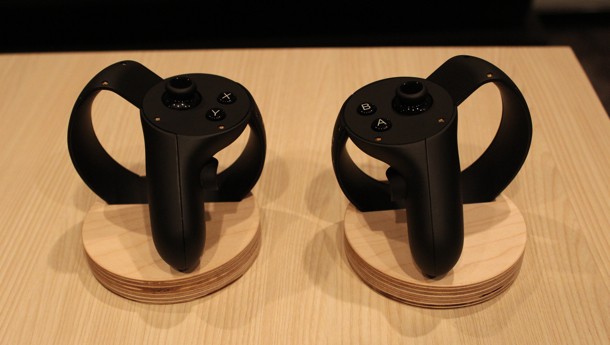Please support Game Informer. Print magazine subscriptions are less than $2 per issue
E3 2015 Virtual Reality Roundup: Oculus, Morpheus, HoloLens, And More

For the past three years, E3 has become an increasingly large stage for virtual reality leaders and hopefuls. This year, three major players all showcased new technology and experiences, with support from a variety of developers.
We also got a chance to check out a couple of third-party peripherals that might have longer-term impact on how we experience virtual and mixed reality experiences.
Oculus Rift (Consumer Version 1)
Company: Oculus
Estimated Release: Q1 2016
Oculus has walked a long, public road from its early days. We first got eyes on with the first Rift developer kit, leaving us with a mixture of awe and skepticism.
While the hardware was certainly leaps and bounds beyond the enormous technology of the 1990s, it wasn’t ready for prime time. Oculus founder Palmer Luckey and other team members were clear that the company’s earliest prototype was far from good enough for consumer use.
Fast forward through the Crystal Cove prototype (positional tracking), developer kit 2 (HD), and the Crescent Bay prototype (improved persistence and integrated audio). Oculus has now unveiled the form factor that it will sell to consumers, and I had the chance to go eyes-on with it.
The first thing I noticed was that the Rift feels lighter. I say “feels” because Oculus CEO Brendan Iribe points out that this is in part due to a redistribution of weight from the front to the top of the head.
Putting the Rift on is now akin to wearing a baseball cap, and for the first time I didn’t feel like gravity was working to pull the head-mounted display down my face. The visual experience was extremely similar to the Crescent Bay demo, with imperceptible persistence (which appears as image smearing or a “screen door” effect).
I tried a number of demos with the Rift CV1 to get a feel for comfort levels. Third-person gaming is going to be bigger in virtual reality than many people realize. There’s an assumption, one that is mercifully waning, that first-person gaming is going to be VR’s bread and butter.
While some first-person experiences will no doubt be successful, immersive third-person gaming is by and large more comfortable and more familiar. Being “the camera” instead of the actor also mitigates some potential simulation sickness and “presence” issues that might be caused by violent acts.
Both Insomniac’s Edge of Nowhere, a Lovecraftian adventure set in the arctic, and Gunfire Games’ Chronos were exceptional applications of the technology. These are both third-person experiences, and completely immersive.
First-person can clearly work, though. A hockey demo that puts players in front of the goal requires little movement, but benefits greatly from putting the player behind the goalie’s eyes. The limited field of view in first-person (compared to third-person) required frantic puck tracking and split-second reactions.
Audio was crucial in all three of these demos, and I was extremely impressed by the onboard audio option. As I mentioned when first trying Project Morpheus at GDC 2014, the software powering the positional audio is crucial for immersion, and Oculus seems to have nailed it.
You’ll still be able to use your own earbuds or cans (Oculus’ integrated solution is easily removable from the HMD). So if you are an audiophile determined to use your high-end gear, you won’t have an issue.
The engineering sample we used isn’t the final manufacturing model, but it’s close. Final weight hasn’t been disclosed yet, nor has specific field of view, but Iribe says it’s over 150 degrees.
On the next page, we look at two Oculus demos and the innovative Oculus Touch VR controllers.

Oculus Touch (Controllers)
Company: Oculus
Estimated Release: First Half 2016
When we sat down with Palmer Luckey at GDC 2014, we discussed input for virtual reality at length. "You don't want just an input device," he told us. "Something like a Kinect or a mouse, they are very much input devices. You are making something happen in the virtual world, but nothing is coming back out. What you really want is something like the headset that allows you to manipulate the virtual world and feel sensations from and have good haptic sensations from the world."
At the end of Oculus’ pre-E3 press conference, the company finally unveiled its first attempt at a solution. The Oculus Touch is designed with sensors so that you can “see” your hands in virtual space and smartly positioned triggers to make manipulation feel natural.
We spent time in Oculus’ toy box environment, which gave us the chance to pick up and throw blocks, steer a toy tank with a handheld remote control, and use a slingshot to take aim in a shooting range. My accuracy was surprisingly good with the slingshot, and learning how to grasp on pinch came quickly.
Tossing objects to the guide running my demo was natural thanks to the palm trigger. And the Touch controllers were comfortably and securely tethered to my wrists, so I never worried about the potential of dropping the prototypes.
The Oculus Touch likely won’t be ready for the first quarter release of the head-mounted display. However, the company says that it will begin taking pre-orders alongside the Rift. All Rift units will ship with an Xbox One controller and the wireless Windows 10 adapter, even after the Touch controllers are out.
Speaking with Oculus vice president of product Nate Mitchell, the reason for the Microsoft partnership became clear. Mitchell told me that giving every user a gamepad means that developers who have been programming for that input method for three years will have a 100 percent install base guaranteed.
It’s going to take time for Oculus Touch development to ramp up to the same level, though there will no doubt be experiences ready for the innovative controllers at launch. Expect that the gamepad will be the default, possibly through the first consumer Rift’s product cycle of two to three years (as discussed in our interview with CEO Brendan Iribe).

Back to Dinosaur Island 2
Developer: Crytek
Hardware: Oculus Rift Crescent Bay Prototype, Xbox One Controller
Crytek's virtual reality tech demo, Back to Dinosaur Island 2, is the basis for its first full VR game, Robinson: The Journey. The brief experience put me in control of a pair of hands (and presumably the person to whom they are attached). The gameplay was simple: pressing the trigger grips, releasing lets go.
The purpose of the demo is to ascend a cliff face using motorized pulleys. At the end of one, I needed to reach one hand to the next, grip, then move the other hand over.
The tropical scenery, including a waterfall, were well rendered, and the enormous flying dinosaurs were imposing and impressive. At the top of the cliff, there are waypoints to scan (just by looking), and I was disappointed that I wasn't able to move around and explore the lush terrain.
I'm interested to see if Crytek can translate this demo into a full game and how it will adapt length of play session to first generation virtual reality. The developer says it is platform agnostic, which means we might see Robinson appear on Valve's VR headset and other contenders.

Time Machine VR
Developer: Minority Media
Hardware: Oculus Rift Crescent Bay Prototype, Xbox One Controller
Most of what we’ve seen during virtual reality hardware demos has been brief. The experiences have largely been tuned to show off the technology rather than viable games.
Minority Media breaks that mold, with the longest demo I’ve ever played using Oculus Rift. Time Machine VR will be a launch title when the head-mounted display arrives early next year, and I can’t wait to check out the full game.
The premise is simple. Time travel has been realized, and it’s up to the player to go back in time to research dinosaurs. The gameplay is entirely first person, but thanks to being seated in a slow-moving pod, underwater, it’s extremely comfortable.
While investigating different creatures, I needed to use a variety of tools to detect movement and collect data. There is a limited “freeze” feature that stops time outside the pod, useful for approaching and scanning aggressive wildlife.
The visuals are impressive, and the enormous dinosaurs swimming around me were terrifying. While there is a heavy educational component, the end of the demo hints that there is far more to Time Machine than meets the eye.
Right before the experience ended, the time controls went awry and I was sent too far back. I encountered a strange artifact, and if that’s where the story really begins, I’ll be delighted to find out where it goes next year.
I’ve had VR experiences both comfortable and cringeworthy. When I came out from the Time Machine demo, 40 minutes had passed without even the slightest bit of recognition that was how long I was under. I experienced no discomfort whatsoever, and could have easily gone on for much longer.
Minority Media has a winner on its hands. This is the kind of experience that I hope people have the chance to try early on in VR’s commercial life.
Read on for our experience with the latest version of Sony’s Morpheus.

Project Morpheus
Company: Sony
Estimated Release: First Half 2016
We’re getting much closer to the release of commercial virtual reality. Oculus and Sony are on parallel paths, with two different target markets (PC and console respectively).
Sony has a bit more time to spend tuning the experience and working on real software. With the exception of RIGS, a mech-based sports game available on the show floor, everything else we tried seemed to be a tech demo or indie title.
The Morpheus headset isn’t quite as comfortable as the consumer Rift. Too much of the weight is still on the front of the device, meaning it needs to be overtightened across the back to compensate for gravity pulling it down.
The demos I tried were examples of good VR, but not necessarily games I’d want to play for long periods of time. The best of them was 3D puzzler Superhypercube. Players are tasked with fitting a growing collection of attached cubes through a slot in a barrier. It plays out like the Hole in the Wall gameshow without the embarrassment.
Other demos included a first person god game called Godling, in which a disembodied voice attempts to teach you how different elements like water and fire impact the world, a car chase shooter set in London, and a rudimentary first-person shooter. One demo, Playroom VR, features the cute robots from the PlayStation 4 Playroom app.
This minigame is a multiplayer affair with up to four players using controllers and the television running from the player with the headset in the role of a monster. While wearing the Morpheus, I had to use my head to knock down buildings along a road before eventually reaching a pier.
At the pier, the robot players fight back by throwing objects. Dodging is also handled with head movements, and the tracking worked fairly well. It was a cute minigame, but again, not something I’d want to spend any length of time playing.
We’ve yet to see much from Sony by way of serious games for the Morpheus. That will need to change as early as Paris Games week, when the company has its next big showing.
I’m sold on Morpheus as a technology, especially given its out of the box accessibility when connected to a PS4. I’m not convinced that there will be enough content to make it worthwhile though.

Loading Human
Developer: Untold Games
Hardware: Sony's Project Morpheus
The Loading Human demo was extremely brief, which is a shame because the game shows potential. With a PlayStation Move controller in each hand, I had to locate a keycard in a book (first by picking up the book, and then removing the card with my other hand).
From there, I had to swipe the card to access controls to raise a blast shield. This cut the light in the room, so I needed to use a flashlight to see my way around.
The most impressive part was after picking up a ringing phone, the sound reflected the distance between the handset and my ear. I had to hold the phone up to my head in order to hear the message.
Loading Human is designed to be a classic point and click adventure in virtual reality. Right now, the controls are not ideal, though. Turning with two of the Move buttons is jarring. There is another control option that does tie pivoting to head position, and I would have preferred to experience that.
Provided that the walking speed can be increased (I suspect it was tuned way down for comfort purposes), this could be a great launch or early life cycle title that shows off the narrative capacity of the technology. Though I'm a little wary of the promise of being kissed by a female love interest. I think we should get to know each other first.
Head on for the conclusion featuring Microsoft HoloLens and two peripherals that may enhance VR immersion.

HoloLens
Company: Microsoft
Estimated Release: “In the Windows 10 timeframe,” according to Microsoft vice president Kudo Tsunoda
When I spoke with Microsoft vice president Kudo Tsunoda, he was clear that HoloLens is not first and foremost a gaming application. After trying it for myself, I think that’s the right approach.
“Presence” is starting to become one of those annoying buzzwords that pops up anytime someone even mentions virtual or mixed reality. It refers to the sense of being transported as a result of altered reality. We used to call it “suspension of disbelief.”
So, I ask your forgiveness when I say that HoloLens has problems with “presence” and immersion due largely to its narrow field of view. The first thing you need to understand about HoloLens, is that unlike virtual reality displays, you can carry on your normal activities wearing it.
I had no problem looking around and walking while wearing HoloLens. The only difference was that there were images overlaid in my field of view that looked quite real.
The demo in which I participated led up to a Halo Warzone match. My interpupillary distance was measured, I was fitted with a HoloLens, and then told to walk toward a Halo-style waypoint down the hall.
This was quite cool, as was watching a window shield slide away to reveal a Pelican coming in for landing and other UNSC craft. The integrated audio sealed the deal, making it an experience entirely unlike virtual reality.
Afterward, we gathered around a war table for a briefing from Spartan Sarah Palmer. She walked around the table, brought up maps to show off the different features of the Warzone map, and briefed us on the rules of engagement.
If only the image wasn’t cut off every time I shifted slightly. Each time I leaned just a bit, I was reminded that the holograms weren’t really there. I was pulled out of the moment entirely as I tried to shift back and hold still so that I could see the entire thing.
In the span of the five-minute briefing, this happened at least half a dozen times. And according to reports, the field of view isn’t going to improve.
For experiences that don’t require immersion, like Tsunoda’s example of rewiring a light switch with the help of someone via HoloSkype, the technology is brilliant. In that case, it’s a tool like any other.
For entertainment though, having the image shift or cut off can be as distracting as a screaming child. When I was focusing on repositioning myself to see better, I wasn’t paying attention to the content. It’s a problem that may not be surmountable, at least not immediately. Until it is, I’ll remain skeptical of HoloLens’ value as an entertainment platform. For more on HoloLens, check out Bryan Vore's writeup.

Manus Machina (Controller)
Company: Manus Machina
Estimated Release: TBD
While Oculus is starting to solve the issue of integrating a user’s hands into virtual reality its own way, others are hard at work on other solutions. One such company is Manus Machina.
Manus Machina (the eponymous product made by the company) is a virtual reality glove with a sensor array attached to the back. My demo with them was limited, but I was impressed at the prototype’s ability to track individual digit movement and position.
There’s still room for improvement in the tracking, but I’m curious to see where the company is able to take the technology. I’ve tested a number of VR input mechanisms, and this one shows quite a lot of promise.

SubPac S2
Company: SubPac
Estimated Release: Out Now, $379
Square Enix teamed up with SubPac to show off the tactile bass system alongside three Just Cause 3 trailers. The SubPac S2 rests against the seat back and transfers low frequency sounds directly to the body.
The vibrations give an extra dimension to bass lines and booms caused by on-screen explosions. The devices were originally envisioned and released as wearables for DJs and producers on the club scene.
While the SubPac wasn’t presented as a VR accessory when I saw it, it’s easy to see how the technology could be used to enhance immersion while wearing a head-mounted display. At $379, you might want to find somewhere to try one out before you decide to dive in headfirst.










